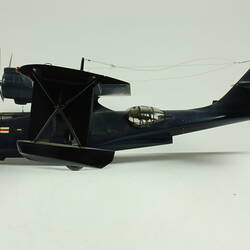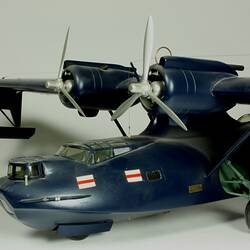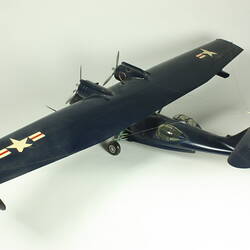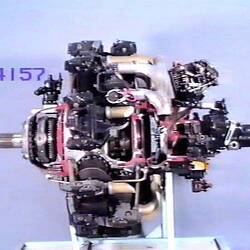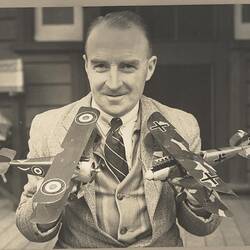Summary
Model History
1:32 scale model commissioned by Museum Victoria and built by Mr Harold P. Wood in 1955. It is finished in a post-1945 US military scheme but has an early type rounded tailplane design which is not correct for the PBY-5A.
One of the most versatile flying boat designs ever built, the PBY was made by Consolidated to a US Navy requirement. Designer Isaac Macklin 'Mac' Laddon based the PBY on his previous P2Y design but with aerodynamic improvements and a distinctive broad semi-cantilever wing on which were mounted two Pratt & Whitney Twin Wasp engines. The prototype flew in 1935. An early Model 28-2 civilian version of the PBY named Guba II was used in New Guinea by the American Museum of Natural History on a scientific expedition in 1938-39. Australian, Patrick Gordon Taylor later used the same aircraft to conduct a 1939 survey of the Indian Ocean area for possible air bases to link Australia and Africa. This was the first flight across the Indian Ocean.
During World War II, the PBY was used by the US, British Commonwealth and Soviet Union. Its great range (about 3,700 km) made it suitable for reconnaissance and U-boat patrol work. The PBY-5A version was equipped with retractable undercarriage to enable land and water operation. The RAAF received its first 18 Catalinas (as they were known by British users) in 1941, flown across the Pacific from California with mixed Qantas and RAAF crews. A total of 168 Catalinas of several types were received by the RAAF. Painted black, some were operated on long-range bombing and mine-laying missions as far north as Hong Kong.
In Victoria, No. 1 Flying Boat Repair Depot was established at Lake Boga which repaired and overhauled RAAF Catalinas as well as other types of flying boats. Qantas also flew Catalinas as the only regular wartime air service to Australia. These aircraft flew between Perth and Ceylon from 1943 to 1945. Passengers received a 'Secret Order of the Double Sunrise' certificate as the flight was usually about 31 hours duration. In 1951, P.G Taylor flew an ex-RAAF Catalina named 'Frigate Bird II' to Chile, the first flight between Australia and South America. This aircraft is now held in the collection of the Powerhouse Museum in Sydney. The Catalina was also used by Trans Australia Airlines (TAA) in New Guinea in the early 1960s.
Physical Description
Navy twin propeller aeroplane model with three wheels. Features red and white painted flags.
More Information
-
Collection Names
-
Collecting Areas
-
Acquisition Information
Purchase
-
Modelmaker
Mr Harold P. Wood, Courang Road, Glen Iris, Greater Melbourne, Victoria, Australia, 1955
-
Brand Names
-
Classification
Air transport, Aircraft, Model propeller aircraft - military
-
Category
-
Discipline
-
Type of item
-
Overall Dimensions
955 mm (Width), 620 mm (Depth), 200 mm (Height)
Measurements of model only. 'Width' is model wingspan, 'Depth' is model length from nose to tail, 'Height' is overall model height while resting on its undercarriage.
-
Model Scale
1:32
-
Keywords
Aeroplanes, Military Aircraft, Model Aeroplanes, Reconnaissance Aircraft, Scale Models, Wars & Conflicts

